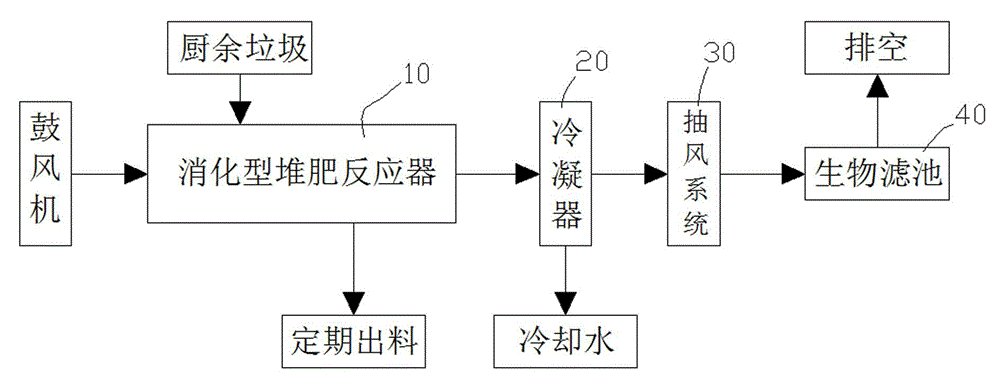In-situ reduction method for kitchen wastes in residential communities
A kitchen waste reduction technology, applied in the direction of climate change adaptation, organic fertilizer, etc., can solve the problems of high operating cost, long process flow, and complicated operation, and achieve secondary degradation fermentation, high processing efficiency, and low energy consumption. consumption effect
- Summary
- Abstract
- Description
- Claims
- Application Information
AI Technical Summary
Problems solved by technology
Method used
Image
Examples
Embodiment 1
[0028] Follow the steps below to dispose of kitchen waste:
[0029] (1) Take kitchen waste and landscaping waste at a volume ratio of 1:1 for composting and reduction treatment.
[0030] (2) Use the domesticated microbial active substrate as the microbial source for composting. The microbial active substrate is about 500 liters (L), and 40 liters (L) of kitchen waste is added every day. After 3 days, the temperature of the reaction system is raised to 50°C. After that, Start feeding normally.
[0031] (3) Feeding operation, put kitchen waste (360L) and landscaping waste (360L) into the closed composting reactor at a volume ratio of 1:1 every day and mix them evenly; adjust the moisture content of the mixed materials to 65%, the carbon-to-nitrogen ratio (C / N) was adjusted to 20:1, and the pH was adjusted to 6.5. In the operation process, after feeding the materials every day, manually start the rotary machine, let the reactor rotate for 0.5 hours (h), so that the materials ca...
Embodiment 2
[0042] Follow the steps below to dispose of kitchen waste:
[0043] (1) Take kitchen waste and landscaping waste at a volume ratio of 1:1.5 for composting reduction treatment;
[0044] (2) Use the domesticated microbial active substrate as the microbial source for composting. The microbial active substrate is about 500 liters (L), and 40 liters (L) of kitchen waste is added every day. After 3 days, the temperature of the reaction system is raised to 50°C. After that, Start feeding normally.
[0045] (3) Feeding operation, put kitchen waste (360L) and landscaping waste (540L) into the closed composting reactor at a volume ratio of 1:1.5 every day and mix them evenly; adjust the moisture content of the mixed materials to 60%, the carbon-to-nitrogen ratio (C / N) was adjusted to 25:1, and the pH was adjusted to 7.0. In the operation process, after feeding the materials every day, manually start the rotating machine, let the reactor rotate for 0.5h, so that the materials can be dyna...
Embodiment 3
[0056] Follow the steps below to dispose of kitchen waste:
[0057] (1) Take kitchen waste and landscaping waste at a volume ratio of 1:2 for composting reduction treatment;
[0058] (2) The domesticated microbial active substrate is used as the microbial source for composting. The microbial active substrate is about 500L, and 40L of kitchen waste is added every day. After 3 days, the temperature of the reaction system rises to 50°C, and then normal feeding begins.
[0059] (3) Feeding operation, put kitchen waste (360L) and landscaping waste (720L) into the closed composting reactor at a volume ratio of 1:2 every day and mix them evenly; adjust the moisture content of the mixed materials to 55%, the carbon-nitrogen ratio (C / N) was adjusted to 30:1, and the pH was adjusted to 7.5. In the operation process, after feeding the materials every day, manually start the rotating machine, let the reactor rotate for 0.5h, so that the materials can be dynamically stirred, and the venti...
PUM
 Login to View More
Login to View More Abstract
Description
Claims
Application Information
 Login to View More
Login to View More - R&D
- Intellectual Property
- Life Sciences
- Materials
- Tech Scout
- Unparalleled Data Quality
- Higher Quality Content
- 60% Fewer Hallucinations
Browse by: Latest US Patents, China's latest patents, Technical Efficacy Thesaurus, Application Domain, Technology Topic, Popular Technical Reports.
© 2025 PatSnap. All rights reserved.Legal|Privacy policy|Modern Slavery Act Transparency Statement|Sitemap|About US| Contact US: help@patsnap.com



